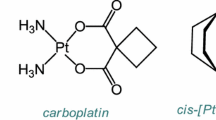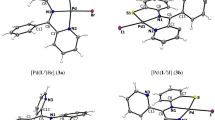Summary
New palladium(II) complexes of Schiff bases, obtained from 5-aminouracil, (AUH), and acetylacetone (AUAcAcH2), benzaldehyde (AUBALH), furan-2-aldehyde (AUFALH), 2-hydroxynaphthaldehyde (AUNALH2), pyridine-2-aldehyde (AUPyALH) or salicylaldehyde (AUSALH2) and from 1,2-dihydro-1,5-dimethyl-2-phenyl-4-amino-3H-pyrazol-3-one (AAPy) and acetylacetone (AAPyAcAcH), 2-hydroxyacetophenone (AAPyAPH), furan-2-aldehyde (AAPyFAL), pytidine-2-aldehyde (AAPyPyAL), or salicylaldehyde (AAPySALH), have been prepared. The complexes, with formulae PdL2Cl2 (L=AUBALH, AUFALH or AUSALH2); PdLCl2 (L=AUAcAcH2, AUNALH2, AUPyALH, AAPyFAL or AAPyPyAL) and PdLCl (L=AAPyAcAc or AAPySAL) were characterized by elemental analysis, i.r. and electronic spectral studies, thermogravimetric analyses and magnetic and conductance measurements. The x-ray powder diffraction pattern of one of the complexes was also examined. The complexes were screened for their possible antitumour activityin vitro.
Similar content being viewed by others
References
S. Krischner, A. Maurer and D. Dragulesku,J. Clin. Hamatol. Oncol.,7, 293 (1977).
M. J. Cleare,Platinum Met. Rev.,23, 53 (1979).
U. Hisao, T. Mariko and F. Takamasa,Chem. Lett.,4, 751 (1987);Chem. Abst.,108, 112694j (1988).
A. I. Vogel,A Textbook of Quantitative Inorganic Analysis, Longmans, London, 1961.
R. Kuttan, P. Bhanumathy, K. Nirmala and M. C. George,Cancer Lett.,29, 197 (1985).
A. M. Shallary, M. M. Mostofa and M. M. Bekhheit,J. Inorg. Nucl. Chem.,41, 267 (1979).
C. J. Ballhausen and H. B. Gray,Inorg. Chem.,1, 111 (1962).
Samir Mansy and R. Stuart Tobias,Inorg. Chem.,14, 287 (1975).
M. G. Goodgame and D. A. Jakubonic,Coord. Chem. Rev., 79 (1987).
C. P. Prabhakaran and B. G. Nair,Transition Met. Chem.,8, 368 (1983).
J. Chacko, C. P. Prabhakaran and C. G. R. Nair,J. Inorg. Nucl. Chem.,38, 1555 (1976).
K. Laxma Reddy, S. Srihari and P. Lingaiah,Indian J. Chem.,23A, 780 (1984).
A. B. P. Lever,Inorganic Electronic Spectroscopy, Elsevier, Amsterdam, 1968.
B. Keshavan and R. Janardhan,Transition Met. Chem.,9, 197 (1984).
R. Hesse,Acta Crystallogr.,1, 200 (1948).
H. Lipson,Acta Crystallogr.,2, 43 (1949).
K. F. Purcell and J. C. Kotz,Inorganic Chemistry, Saunders Philadelphia, London, Toronto, 1977.
Author information
Authors and Affiliations
Rights and permissions
About this article
Cite this article
Cherayath, S., Alice, J. & Prabhakaran, C.P. Palladium(II) complexes of Schiff bases derived from 5-amino-2,4-(1H, 3H)pyrimidinedione (5-aminouracil) and 1,2-dihydro-1,5-dimethyl-2-phenyl-4-amino-3H-pyrazol-3-one. Transition Met Chem 15, 449–453 (1990). https://doi.org/10.1007/BF01040774
Received:
Issue Date:
DOI: https://doi.org/10.1007/BF01040774




